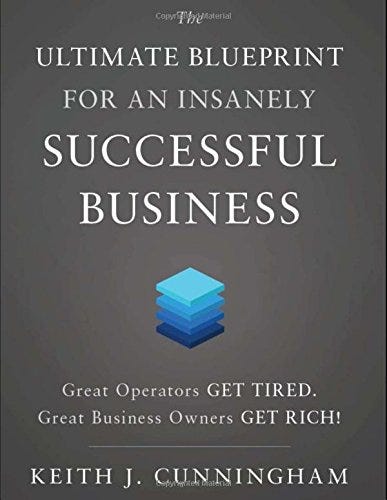Week 5: Investment Types
Debt and Equity Deals
I am in Whistler, B.C., this week for a financial event, where I will be surrounded by like-minded people trying to make the most of their financial situation. The event will feature billionaire speakers and a lot of learning opportunities. To stay on theme, my Adding Value section will feature how our two main types of deals work: Debt and Equity. Also, Whistler is beautiful. Here is my take on it:
This edition has the following sections:
Learning: Books, Videos, etc
Adding Value: Types of Investments
Interesting things: Tweets, podcasts, articles
Other Stuff
Enjoy!
Learning:
The Ultimate Blueprint for an Insanely Successful Business
Keith Cunningham's "The Ultimate Blueprint for an Insanely Successful Business" focuses on measuring business performance and managing cash flow rather than pursuing revenue growth. The book emphasizes the need for business owners to understand and utilize critical financial metrics to make informed decisions and ensure long-term success. Cunningham advocates for a disciplined approach to business management, highlighting the role of effective asset utilization and efficiency in converting revenue into profits.
I read this book about 6 months ago, and it has shifted how I think about our company regarding finances. I used to want to grow at all costs, but it made me understand how important it is to
Know your numbers: You don't have to be an accountant, but you should know how much money is regularly coming in and out of your business. Keith discusses strategies for keeping a "scorecard" for your business financials.
Get the most out of your assets: This refers to how efficient your employees, equipment, and materials are. I'd rather own a company that does $2M in sales and $1M in net profit with two employees than one that does $20M in sales and the same $1M in profit with 20 employees.
Residential Underwriting Course: How to Find and Analyze Deals
Last week, I announced that I'm doing a one-day workshop where I go in-depth on our process of analyzing residential land. An old saying in this industry is: "You make money in real estate when you buy." This class will give you the tools to "make money when you buy."
In this workshop, I will go over:
How to identify land
How do we decide whether we can make money in a market
What determines whether we will buy a piece of land
How we analyze the deal
How we estimate our costs
Land
Materials
Labor
Financing
This class will come with free one-year access to our underwriting tool, the Acristo Engine, which will help you underwrite deals quickly and accurately ($100 value). I am offering this class at a large discount for my subscribers. It’d be foolish not to take up the offer.
Adding Value
Debt and Equity Partnerships
When we take money from an investor, the two main ways we structure the deals are through debt and equity partnerships.
Let's create a hypothetical: I am looking for investors to raise money for a new construction project. I take them to lunch, where we start discussing non-business-related topics. After we eat, we shift the focus to the deal.
I explain how we structure our deals with a joint venture agreement. With this partnership, two or more parties work on a specific project or business activity. They share resources, risks, and rewards to achieve a common goal. In this case, they will bring the money, and I will provide the work.
For the capital raise, we collect approximately one-third of the construction costs from investors, with the remainder funded by ourselves and a construction loan.
Then, I present the investor with two options:
A debt partnership where we repay the investor and the lender from the proceeds upon project completion and subsequent sale or refinancing, retaining any profits. I tell him this model is preferred for its clear return to investors and greater control over the asset's future. He earns a clear percentage of his money from the beginning. I can control the asset better and adjust to market conditions.
He then asks if he can own a percentage of the property. I respond that we can do an equity partnership where, depending on the project's outcome
Keep reading with a 7-day free trial
Subscribe to Adan’s Newsletter to keep reading this post and get 7 days of free access to the full post archives.





